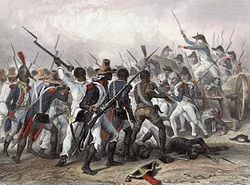
A slave rebellion is an armed uprising by enslaved people, as a way of fighting for their freedom. Rebellions of enslaved people have occurred in nearly all societies that practice slavery or have practiced slavery in the past. A desire for freedom and the dream of successful rebellion is often the greatest object of song, art, and culture amongst the enslaved population. Many of the events, however, are often violently opposed and suppressed by slaveholders.

Slavery in the colonial history of the United States, from 1526 to 1776, developed from complex factors, and researchers have proposed several theories to explain the development of the institution of slavery and of the slave trade. Slavery strongly correlated with the European colonies' demand for labor, especially for the labor-intensive plantation economies of the sugar colonies in the Caribbean and South America, operated by Great Britain, France, Spain, Portugal, and the Dutch Republic.
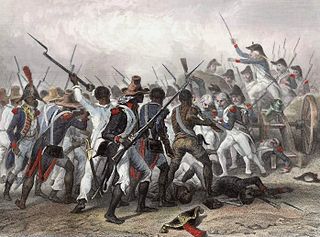
Gabriel's Rebellion was a planned slave rebellion in the Richmond, Virginia, area in the summer of 1800. Information regarding the revolt, which came to be known as "Gabriel's Rebellion", was leaked prior to its execution, and Gabriel, a blacksmith who planned the event, and twenty-five followers were hanged. The site of Gabriel's execution was for several years believed to have been at the Shockoe Bottom African Burial Ground, historically known as the Burial Ground for Negroes. His execution was advertised as occurring at the usual place, however in 1800 that may have been a location other than the Burial Ground for Negroes. The location of Gabriel's burial is also unknown.
The StonoRebellion was a slave revolt that began on 9 September 1739, in the colony of South Carolina. It was the largest enslaved rebellion in the Southern Colonies, with 25 colonists and 35 to 50 Africans killed. The uprising was led by native Africans who were likely from the Central African Kingdom of Kongo, as the rebels were Catholic and some spoke Portuguese.

Denmark Vesey was an 18th century and early 19th century free Black and community leader in Charleston, South Carolina, who was accused and convicted of planning a major slave revolt in 1822. Although the alleged plot was discovered before it could be realized, its potential scale stoked the fears of the antebellum planter class that led to increased restrictions on both slaves and free blacks.
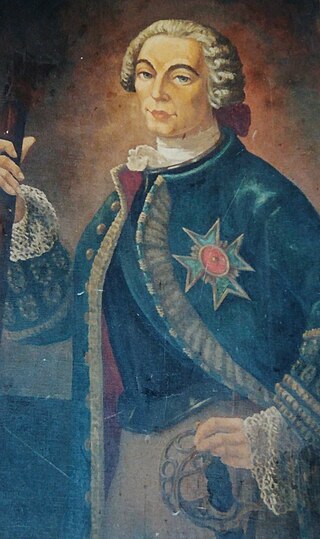
Étienne Perier or Étienne de Perier, also known as Perier the Elder, was a French naval officer and governor of French Louisiana from 1726 to 1733. His time as governor included some notable achievements, including the construction of the first levee along the Mississippi River in 1727. In response to the Natchez Revolt, he attempted to completely destroy the Natchez people, which increased Native American hostility toward the French in the territory. Because he failed to secure the safety of the colony, Perier was recalled as governor in March 1733. He later distinguished himself as a naval officer and privateer, including during the capture of HMS Northumberland in 1744.

The New York Slave Revolt of 1712 was an uprising in New York City, in the Province of New York, of 23 Black slaves. They killed nine whites and injured another six before they were stopped. More than 70 black people were arrested and jailed. Of these, 27 were put on trial, and 21 convicted and executed.

Nat Turner's Rebellion, historically known as the Southampton Insurrection, was a rebellion of enslaved Virginians that took place in Southampton County, Virginia, in August 1831. Led by Nat Turner, the rebels killed between 55 and 65 White people, making it the deadliest slave revolt in U.S. history. The rebellion was effectively suppressed within a few days, at Belmont Plantation on the morning of August 23, but Turner survived in hiding for more than 30 days afterward.
There were significant slave revolts in Brazil in 1798, 1807, 1814 and the Malê Revolt of 1835. The institution of slavery was essential to the export agriculture and mining industries in colonial Brazil, its major sources of revenue. A marked decrease in the Indian population due to disease necessitated the importation of slaves early in the colonial history of Brazil with African slaves already being enslaved in greater amounts than Indian slaves on sugar plantations in the Bahia region by the end of the 1500s. A gold and diamond boom in the interior of Brazil in the mid-eighteenth century precipitated a significant increase in the importation of African slaves.
Antoine-Simon Le Page du Pratz (1695?–1775) was a French ethnographer, historian, and naturalist who is best known for his Histoire de la Louisiane. It was first published in twelve installments from 1751 to 1753 in the Journal Economique, then completely in three volumes in Paris in 1758. After their victory in the Seven Years' War, the British published part of it in translation in 1763. It has never been fully translated into English.
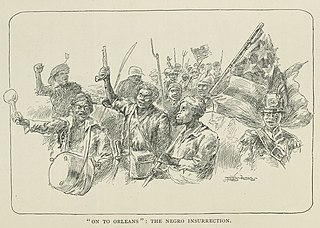
The 1811 German Coast uprising was a revolt of slaves in parts of the Territory of Orleans on January 8–10, 1811. The uprising occurred on the east bank of the Mississippi River in what is now St. John the Baptist, St. Charles and Jefferson Parishes, Louisiana. The slave insurgency was the largest in U.S. history, but the rebels killed only two white men. Confrontations with militia, combined with post-trial executions, resulted in the deaths of 95 slaves.

Invisible churches among enslaved African Americans in the United States were informal Christian groups where enslaved people listened to preachers that they chose without their slaveholder's knowledge. The Invisible churches taught a different message from white-controlled churches and did not emphasize obedience. Some slaves could not contact invisible churches and others did not agree with an invisible church's message but many slaves were comforted by the invisible churches.
Jean-François-Benjamin Dumont de Montigny, or Dumont de Montigny, was a French colonial officer and farmer in French Louisiana in the 18th century. He was born in Paris, France, on July 31, 1696, and died in 1760 in Pondicherry, India. His writings about French Louisiana include a two-volume history published in 1753, as well as an epic poem and a prose memoir preserved in manuscript and published long after his death.
Coromantee, Coromantins, Coromanti or Kormantine is an English-language term for enslaved people from the Akan ethnic group, taken from the Gold Coast region in modern-day Ghana. The term was primarily used in the Caribbean and is now considered archaic.
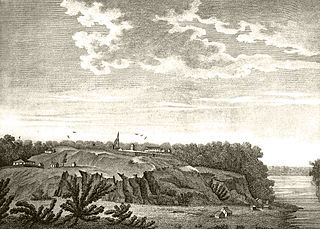
The Natchez revolt, or the Natchez massacre, was an attack by the Natchez Native American people on French colonists near present-day Natchez, Mississippi, on November 29, 1729. The Natchez and French had lived alongside each other in the Louisiana colony for more than a decade prior to the incident, mostly conducting peaceful trade and occasionally intermarrying. After a period of deteriorating relations and warring, Natchez leaders were provoked to revolt when the French colonial commandant, Sieur de Chépart, demanded land from a Natchez village for his own plantation near Fort Rosalie. The Natchez plotted their attack over several days and managed to conceal their plans from most of the French; colonists who overheard and warned Chépart of an attack were considered untruthful and were punished. In a coordinated attack on the fort and the homesteads, the Natchez killed almost all of the Frenchmen, while sparing most of the women and enslaved Africans. Approximately 230 colonists were killed overall, and the fort and homes were burned to the ground.

Marcos Xiorro was the slave name of an enslaved African in Spanish Puerto Rico who, in 1821, planned and conspired to lead a slave revolt against the sugarcane plantation owners and the Spanish Colonial government. Although his rebellion was unsuccessful, he achieved legendary status among the island's slave population and has become part of Puerto Rican folklore.
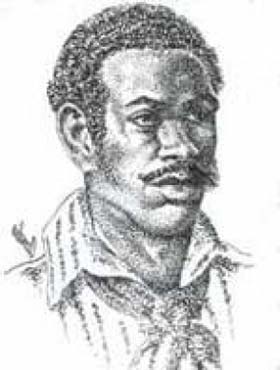
José Antonio Aponte, often known as “Black” José Aponte, was a Cuban political activist and military officer of Yoruba origin who organized one of the most prominent slave rebellions in Cuba, the Aponte Conspiracy of 1812. He held the rank of first corporal in Havana's black militia, and was the leader of his local Yoruba association. Aponte, a free black carpenter in Havana, was proclaimed to be the leader of a plot to rebel against the Cuban government, free the slaves and uplift free people of color, and overthrow slavery in Cuba. The movement struck several sugar plantations on the outskirts of Havana, but it was soon crushed by the government.

Following Robert Cavelier de La Salle establishing the French claim to the territory and the introduction of the name Louisiana, the first settlements in the southernmost portion of Louisiana were developed at present-day Biloxi (1699), Mobile (1702), Natchitoches (1714), and New Orleans (1718). Slavery was then established by European colonists.

Carlota Lucumí, also known as La Negra Carlota was an African-born enslaved Cuban woman of Yoruba origin. Carlota, alongside fellow enslaved Lucumí Ferminia, was known as one of the leaders of the slave rebellion at the Triunvirato plantation in Matanzas, Cuba during the Year of the Lash in 1843–1844. Together with Ferminia Lucumí, Carlota led the slave uprising of the sugar mill "Triunvirato" in the province of Matanzas, Cuba on November 5, 1843. Her memory has also been utilized throughout history by the Cuban government in connection to 20th century political goals, most notably Operation Carlota, or Cuba's intervention in Angola in 1975. Little is actually known about the life of Carlota due to the difficulty and availability of sources in archives. Scholars of Afro-Cuban history have grappled with the dearth of reliable sources that document slaves' lives, and the ability of written documents to accurately encompass the reality of slave life. Slave testimonies obtained under investigations after rebellions provide most of the information surrounding Carlota and her contemporaries, making it difficult to construct a complete understanding of her involvement in the 1843 slave rebellion, much less a detailed biography. She is considered significant by scholars due to her role as a woman in an otherwise male-dominated sphere of slave revolt, as well as the way her memory has been employed in the public sphere in Cuba. Carlota and the uprising at Triunvirato plantation are honored as part of the UNESCO Slave Route Project through a sculpture at the Triunvirato plantation, which has since been turned into a memorial and museum.

The Pointe Coupée Slave Conspiracy of 1795 was an attempted slave rebellion which took place in Spanish Louisiana in 1795. It has attracted a lot of attention and been the subject of much historical research. It was preceded by the Pointe Coupée Slave Conspiracy of 1791.
